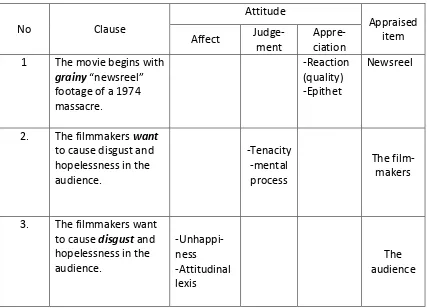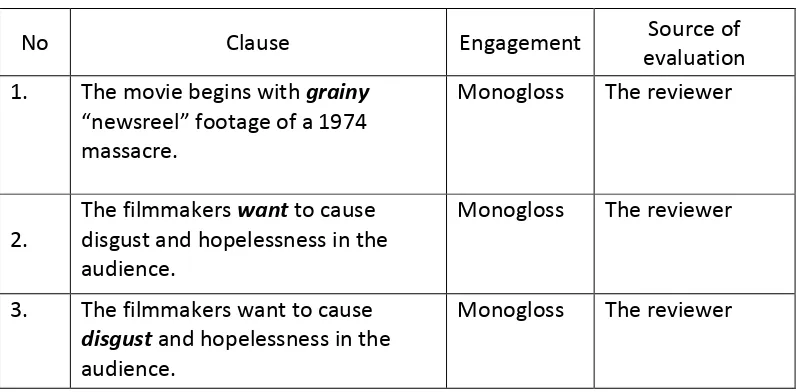27 CHAPTER III RESEARCH METHOD
This chapter contains the research method which is used by the researcher to collect and analyze the data of this research. The research method consists of research design, unit of analysis, source of data, technique of data collection and technique of data analysis.
3.1Research Design
Research design is method that is used by the researcher to analyze the data. The research design in this research is descriptive qualitative. As stated by Alreck & Settle (1995: 408) descriptive research is designed to describe, rather than explain a set of conditions, characteristics, or attributes of people in a population based on measurement of a sample. Moreover, this research is qualitative, in which the collected data are not shown in statistic procedure.
This study is intended to describe appraising items and attitude of reviewer in Texas Chainsaw Massacre (2003) movie review by Roger Ebert. Therefore, this research is not only limited in collecting and organizing the data, but also analyzing and describing it.
3.2Unit of Analysis
28 3.3Source of the Data
The source of the data in this research is review of The Texas Chainsaw Massacre (2003) movie. The review was posted on October 17, 2003 by an American
film critic and movie reviewer, Roger Ebert. The review is posted on his official website www.rogerebert.com u der ategor of Re ie s .
3.4Technique of Data Collection
The data of this research were collected by the following steps: 1. Visiting rogerebert.com
This was the first step in collecting the data. To get the data, the researcher browsed the internet to visit www.rogerebert.com. The researcher chose this website because it is an official website owned by a well-known reviewer, Roger Ebert, which the main focus of the website is to provide movie reviews only. Unlike other websites, all the reviews on this website were sourced from only one reviewer, who was Roger Ebert himself. The following picture is a screenshot of the main page of www.rogerebert.com:
29 2. Searching the movie review
The second step was searching the movie review on the website. This step was done typing the movie title (The Texas Chainsaw Massacre 2003) in the search bar, pressing enter and waiting until the result came up.
.The following picture is the screenshot of the main page of the website with the movie title typed in the search bar, marked by a red box:
Figure 3.2 Movie title in the search bar
3. Choosing the movie review
30 4. Reading the movie review
The fourth step was reading the movie review. This step was done to find out what the reviewer said about the movie and to get better understanding about the review text. The following picture is the screenshot of The Texas Chainsaw Massacre (2003) review text on the website, marked by a red box:
Figure 3.4 Review text of The Texas Chainsaw Massacre (2003)
5. Printing the movie review text
The fifth step was printing the movie review text. This step was done to get the printed copy of the movie review text. The printed copy of the text was easier to read and analyze. The following text is the excerpt of paragraph 1 and 2 of The Texas Chainsaw Massacre (2003) movie review text:
The new version of "The Texas Chainsaw Massacre" is a contemptible film:
Vile, ugly and brutal. There is not a shred of a reason to see it. Those who
defend it will have to dance through mental hoops of their own devising,
defining its meanness and despair as "style" or "vision" or "a commentary on
our world." It is not a commentary on anything, except the marriage of slick
31
The movie is a remake of, or was inspired by, the 1974 horror film by Tobe
Hooper. That film at least had the raw power of its originality. It proceeded
from Hooper's fascination with the story and his need to tell it. This new
version, made by a man who has previously directed music videos, proceeds
from nothing more than a desire to feed on the corpse of a once-living film.
6. Selecting the clauses.
The sixth step was selecting the clauses. This step was done by making clause boundaries and selecting the clauses that contain evaluation toward The Texas Chainsaw Massacre (2003) movie. The purpose of this step was to remove the
lauses that ere ’t dire ted to The Texas Chainsaw Massacre (2003) movie.
In this step, only the clauses containing appraising items toward The Texas Chainsaw Massacre (2003) were selected. The selected clauses became the
data of this research. The examples are as follows: a) Clause 1 and 2 (page 2, paragraph 7,line 1-2)
1. There is a controversy involving Quentin Tara ti o’s Kill Bill: Volu e
1
2. hi h so e people feel is too iole t
These clauses are not selected to be the data, because the first and the
se o d lause are a out a other o ie, Kill Bill: Volu e 1, that’s ei g
compared to The Texas Chainsaw Massacre (2003). These lauses do ’t sho any evaluation toward The Texas Chainsaw Massacre (2003).
b) The e ersio of The Te as Chai sa Massa re is a contemptible film:
vile, ugly, and brutal Clause 3 (Page 1, Paragraph 1, line 1)
32
7. Underlining appraising items in the clauses.
The seventh step is underlining appraising items in each selected clause. This step was done in order to make the analysis process easier. The examples are as follows:
a) The new version of The Te as Chai sa Massa re is a contemptible film: vile, ugly, and brutal (page 1, paragraph 1, line 1-2).
In the clause (a), the appraising items are contemptible, vile, ugly, and brutal.Those appraising items are evaluations toward The Texas Chainsaw
Massacre (2003) movie.
b) The filmmakers want to cause disgust and hopelessness in the audience. (page 1, paragraph 2, line 6)
In the clause (b), the appraising items are disgust and hopelessness. Those appraising items are evaluations toward the audience of The Texas Chainsaw Massacre (2003) movie.
3.5Technique of Data Analysis
The researcher used the qualitative method to analyze the data. The data of this research were analyzed through the following steps:
1.Inserting the clauses into tables.
33 Table 3.1 Example of attitude table
No Clause
Attitude
Appraised item Affect Judge-
ment
Appre- ciation 1 The movie begins with grainy
e sreel footage of a 1974
massacre.
2. The filmmakers want to cause disgust and hopelessness in the audience.
3. The filmmakers want to cause disgust and hopelessness in the audience.
Table 3.2 Example of engagement table
No Clause Engagement Source of
evaluation 1. The movie begins with grainy
e sreel footage of a 1974
massacre.
2. The filmmakers want to cause disgust and hopelessness in the audience.
34 Table 3.3 Example of graduation table
No Clause Graduation Value
Force Focus 1. The movie begins with
grainy e sreel footage
of a 1974 massacre.
2. The filmmakers want to cause disgust and hopelessness in the audience.
3. The filmmakers want to cause disgust and hopelessness in the audience.
2.Classifying the types of appraising items.
35 Table 3.4 Example of attitude classification
No Clause
Attitude
Appraised item Affect Judge-
ment
Appre- ciation 1 The movie begins with
grainy e sreel
footage of a 1974 massacre.
-Reaction (quality) -Epithet
Newsreel
2. The filmmakers want to cause disgust and hopelessness in the audience. -Tenacity -mental process The film-makers
3. The filmmakers want to cause disgust and hopelessness in the audience. -Unhappi- ness -Attitudinal lexis The audience
36
Table 3.5 Example of engagement classification
No Clause Engagement Source of
evaluation 1. The movie begins with grainy
e sreel footage of a 1974
massacre.
Monogloss The reviewer
2.
The filmmakers want to cause disgust and hopelessness in the audience.
Monogloss The reviewer
3. The filmmakers want to cause disgust and hopelessness in the audience.
Monogloss The reviewer
In the table 3.5, it can be seen that the engagements of the three clauses are monogloss, which means the sources of evaluation are coming from the reviewer himself.
Table 3.6 Example of graduation classification
No Clause Graduation Value
Force Focus 1. The movie begins with
grainy e sreel footage of
a 1974 massacre.
-Quality -Attitudinal lexis
Down-scaling
2. The filmmakers want to cause disgust and hopelessness in the audience.
-Process -Attitudinal lexis
Up scaling
37
In the table 3.6, it can be seen that the graduation of the appraising items are put under the force category as quality realized by attitudinal lexis (clause 1), process realized by attitudinal lexis (clause 2), and quality realized by attitudinal lexis (clause 3). The values are determined according to the meaning carried by the lexes.
3.Determining the kinds of appraising items.
This was the third step in technique of data analysis. In this step, the kinds of appraising items found in the data were determined and described. The kinds of appraising items could be in the form of attitudinal lexis, modality, metaphor, clause or other grammatical items. The purpose of this step was to see which kind of appraising item used the most and the least in the text.
4.Explaining the types of attitude.
This was the fourth step in technique of data analysis. In this step, attitudes in the data were explained. By this step, it could be seen which kind of attitude that the researcher used the most and the least in his text.
5.Explaining the engagement
This was the fifth step in technique of data analysis. This step was done to describe the engagement or source of the evaluation. This step showed the source of the evaluation which was more widely used in the text. The source could be from the reviewer or other sources.
6. Explaining the graduation
38 7. Interpreting the data
This was the seventh step in technique of data analysis. In this step, the result of the analysis was interpreted. From the result of attitude analysis, the types of appraising items and the mostly used type of attitude were explained. From the analysis of engagement, the sources of evaluation were described. The last was the analysis of graduation, the attitude of the reviewer was interpreted by the result of the analysis.
8. Drawing conclusion


